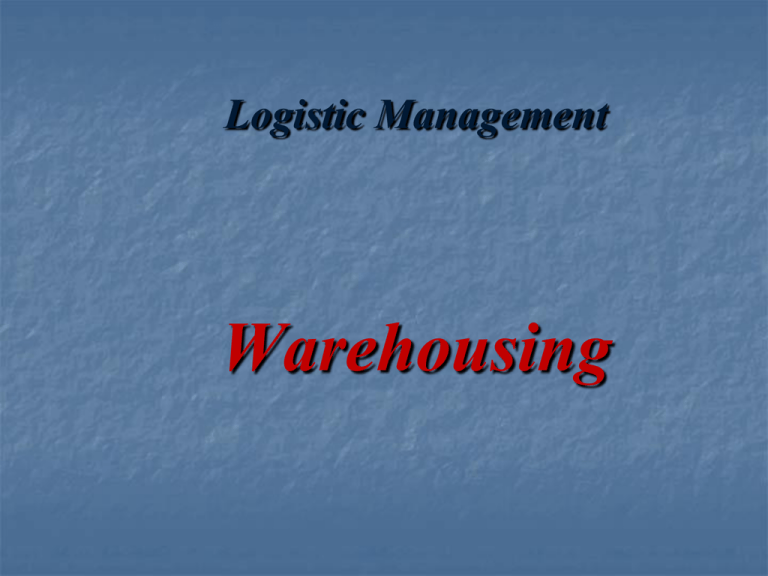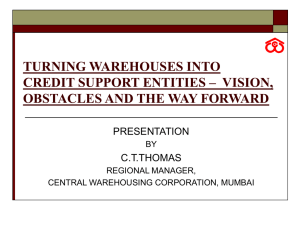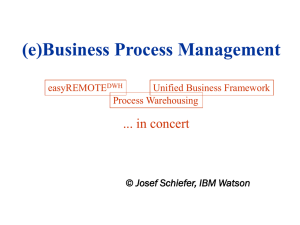public warehouse
advertisement

Logistic Management Warehousing Meaning The warehouse is where the supply chain holds or stores goods. A warehouse is typically viewed as a place to store inventory. However, in many logistical system designs, the role of the warehouse is more properly viewed as a switching facility as contrasted to a storage facility. Objectives •better customer service •low operating cost •Maximum utilization of storage space •Higher labour productivity •Maximum Asset utilization •Reduction in material handling •Increase in inventory turnover •Reduce order filing time Warehousing Function •Material •Material Storage Function Handling Function •Information Handling Function Material Storage function Due to non synchronization of Manufacturing cycle with that of the consumption cycle of the material , storage of the material remains a big hurdle. Holding • Consolidation • Postponement • Break Bulk • packing • Cross Docking •Mixing • FUNCTIONS Material Handling function Efficient short distance movement in or between buildings and a transportation agency. 1)Loading & unloading, 2)Material movement 3)Order filing Information handling function Goods inward Inspection & auditing Goods outward Excess Stock Invoicing Warehouse expenses Transit damage & Breakage Consignment tracking This all information facilitate quick decision Basic Warehouse Operations Movement Receiving Put-away Order picking Shipping Storage Stock location Warehouse Management System (WMS) Warehouse Operations BENEFITS OF WAREHOUSING 1)Consolidation warehouses 1)Shipment consolidation is an economic benefit of warehousing. 2)With this arrangement, the consolidating warehouse receives and consolidates materials from a number of manufacturing plants destined to a specific customer on a single transportation shipment. 3)The benefits are the realization of the lowest possible transportation rate and reduced congestion at a customer's receiving dock Consolidation Warehouses 2) Break bulk warehouses 1)Break bulk warehouse operations are similar to consolidation except that no storage is performed. 2)A break bulk operation receives combined customer orders from manufacturers and ships them to individual customers. 3)The break bulk warehouse sorts or splits individual orders and arranges for local delivery. 4)Because the long-distance transportation movement is a large shipment, transport costs are lower and there is less difficulty in tracking. Break bulk warehouses… Alternative Warehouse Strategies Warehouse alternatives include: (1) Private warehouses, (2) Public warehouses, and (3) Contract warehouses. A private warehouse facility is owned and managed by the same enterprise that owns the merchandise handled and stored at the facility. A public warehouse, in contrast, is operated as an independent business offering a range of services such as storage, handling, and transportation- on the basis of a fixed or variable fee. Public warehouse operators generally offer relatively standardized services to all clients. Alternative Warehouse Strategies... Contract warehousing, which is evolving from the public warehouse segment, provides benefits of both the private and public alternatives. Contract warehousing is a long term, mutually beneficial arrangement which provides unique and specially tailored warehousing and logistics services exclusively to one client, where the vendor and client share the risks associated with the operation Warehousing Strategy… It may be more efficient to build private facilities to cover the 75 percent requirement and use public facilities to accommodate peak demand. Warehousing Strategy… The second form of combined public warehousing may result from market requirements. A firm may find that private warehousing is justified at specific locations on the basis of distribution volume. In other markets, public facilities may be the least-cost option. In logistical system design the objective is to determine whatever combination of warehouse strategies most economically meets customer service objectives. Warehousing Strategy… An integrated warehouse strategy focuses on two questions. The first concerns how many warehouses should be employed. The second question concerns which warehouse types should be used to meet market requirements. For many firms, the answer is a combination that can be differentiated by customer and product. Specifically, some customer groups may be served best from a private warehouse, while a public warehouse may be appropriate for others. Warehouse Layout and Design Develop a demand forecast. Determine each item’s order quantity. Convert units into cubic footage requirements. Allow for growth. Allow for adequate aisle space for materials handling equipment. Warehouse Layout and Design Provide for the transportation interface. Provide for orderpicking space. Provide storage space. Warehouse Layout and Design Principles: Use one story facilities where possible. Move goods in a straightline. Use the most efficient materials handling equipment. Minimize aisle space. Use full building height.









